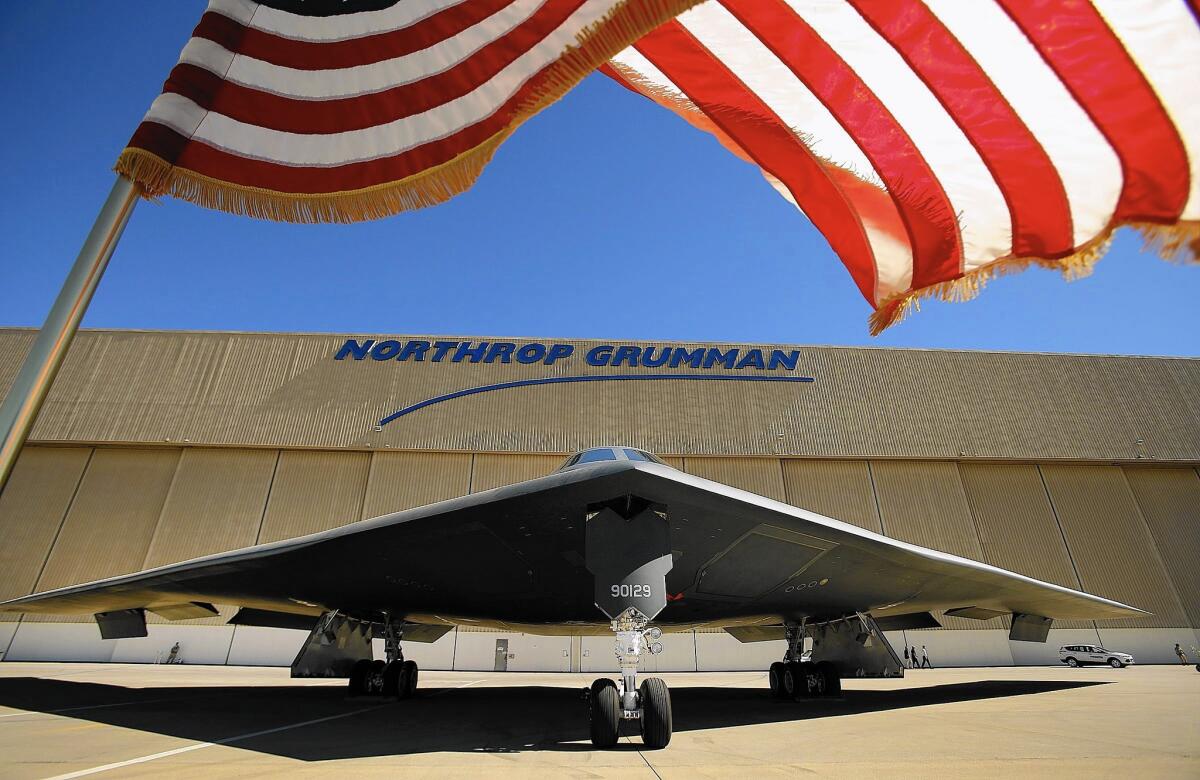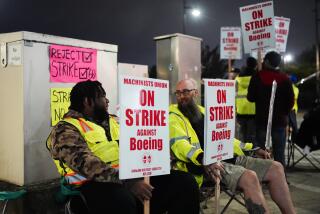New stealth bomber contract likely to be boon for Antelope Valley

The Pentagon is poised to spend billions to build a new stealth bomber, a top secret project that could bring hundreds of jobs to the wind-swept desert communities in Los Angeles County’s northern reaches.
Two teams of defense contractors are now battling to win what would be one of the most expensive contracts in Pentagon history. As the lobbying intensifies, the coming decision to pick a winner as soon as this spring has set off a debate over whether the new warplane is crucial to national security or a colossal budget-busting waste.
“You’re talking about a $2-billion airplane by the time they build it,” said Thomas Christie, who worked as a top analyst inside the Pentagon for more than three decades before retiring. “It’s a disaster waiting to happen.”
But Defense Secretary Chuck Hagel said last month, “I think the Long-Range Strike Bomber is absolutely essential to keep our deterrent edge.”
For elected officials across the country, however, the bomber contract means one thing: jobs. And as the teams led by weapons giants Northrop Grumman and Boeing Co. privately lobby lawmakers for their support, the legislators want to know what their state will get out of the deal.
In an effort to snag jobs for California, Sacramento lawmakers passed bills last summer giving companies hundreds of millions of dollars in potential tax breaks.
In few places can the lure of a new bomber be felt more profoundly than in Palmdale, where the competing teams of contractors have each told local officials that they would perform significant work at their leased facilities at the sprawling expanse of scrub brush known as Air Force Plant 42.
The new jobs would help revive the Antelope Valley’s communities, which have long played an outsized role in military aerospace history and are still struggling to recover from the Great Recession.
“They’ve indicated that they can’t talk about this,” Palmdale Mayor James Ledford said of the defense companies bidding on the contract. “But we can.” And the prospects look good.
Northrop executives have said they would build substantial parts of the company’s proposed bomber in Palmdale, he said, creating an estimated 1,500 jobs.
Rival Lockheed Martin Corp. — the primary subcontractor to Boeing Co. — said it also planned to work on the new warplane in Palmdale, Ledford said. That plan could mean adding 700 jobs, he said.
“It would be the answer to all our prayers,” said R. Rex Parris, mayor of neighboring Lancaster, which has a 10.7% unemployment rate, far higher than the state average.
The decision is in the hands of the Air Force, which says it needs a heavy-payload-carrying bomber that is so stealthy it can evade the most sophisticated enemy radar.
Air Force officials have said the warplane would eventually be outfitted to carry nuclear weapons. They also want it to one day be capable of flying as a drone.
Other details are a closely guarded secret.
To stem criticism of the program’s cost, military officials have vowed to limit the bomber’s price to $550 million each. The Pentagon included $1.2 billion for the bomber in the public portion of this year’s budget. The Air Force plans to award the contract for as many as 100 of the new planes as soon as late spring.
An Air Force spokesman and executives from the companies said they could say little because the bomber is part of the Pentagon’s classified “black budget.”
Located about 70 miles northeast of downtown Los Angeles, the Antelope Valley’s blue skies and open desert spaces make it a prime location for building and testing experimental military planes. For decades, Northrop, Lockheed and Boeing have leased hangars at the Plant 42 complex, where they share a runway with the Air Force and other contractors.
It was here that Northrop developed and built the first stealth bomber, the B-2, during the Cold War, and it continues to perform their maintenance here. The black boomerang-shaped aircraft was designed to penetrate the heart of the Soviet Union.
Over the decades, Lockheed’s engineers have developed a long line of stealthy military flying inventions inside its Palmdale facility known as Skunk Works, including the U-2 spy plane and the F-117 Nighthawk stealth fighter.
The postwar peak in aerospace employment in Southern California came near the end of the Cold War.
In 1987, about 10% of the nation’s aerospace jobs, nearly 200,000 workers, were in Palmdale and the rest of Los Angeles County, according to a county economic development study. Soon thereafter, defense companies began laying off workers by the hundreds.
The county’s aerospace employment fell by nearly 70% — from 189,000 in 1990 to 59,200 in 2011, with most of that decline happening before 2000.
“We’re an aerospace community,” said Ledford, the Palmdale mayor. “We’re not looking to get less. We want more.”
The stakes are high not just for the communities but for the three defense contractors. The industry is coping with the automatic federal budget cuts, known as sequestration, imposed by a 2011 law.
The bomber contract has set off a fierce lobbying battle between Northrop and the Boeing-Lockheed team.
In a rare move for a defense company, Northrop paid for an ad touting its stealthy aircraft during this month’s Super Bowl. The ad, which ended with a shot of a plane veiled in a sheet, appeared only in Washington, D.C., and Dayton, Ohio, the home of top Air Force acquisition officials.
Last summer, lobbyists for Lockheed persuaded Sacramento legislators to pass a bill giving the company hundreds of millions of dollars in potential tax credits if it did extensive work on the new stealth bomber in California.
After Northrop complained, state lawmakers passed a bill giving it a similar potential tax break.
All three companies have previously won Pentagon contracts that blasted through their initial budgets.
During Northrop’s development of the B-2 stealth bomber, the secrecy surrounding the project helped allow costs to soar. The contract was so far over budget that the Pentagon eventually decided to build just 21 of the 132 aircraft it had originally planned. The average cost of each: more than $2 billion.
Todd Harrison, an analyst at the Center for Strategic and Budgetary Assessments, estimated in September that the stealth bomber program would ultimately cost $90 billion — or about $900 million for each plane.
“We have to have a replacement bomber,” Harrison said at a Washington briefing. But it will take money away from other defense projects, he said.
“If you want to put something in,” he said, “something else has to come out.”
The Air Force is already spending billions of dollars to modernize its current fleet of 150 bombers, readying them for the next 25 to 50 years.
The Congressional Budget Office has repeatedly pointed to the new bomber as a program that could be cut. In 2013, its staff said that delaying the new bomber program for 10 years would allow engineers to use more advanced technology to improve its design.
New weapons developed in the next decade may even make the new bomber unnecessary, the office’s staff said.
But the Pentagon says it needs to begin work now on the new bomber. In fact, for years, defense officials may have been secretly funding its development under classified contracts, analysts say.
Last year, Jeremiah Gertler, a Congressional Research Service analyst, said that based on budget figures it appeared the Pentagon was planning to soon put the new bomber into production — suggesting that models had already been built and were being tested.
Lancaster Mayor Parris said the relatively high-paying aerospace jobs had the potential to create many times that number in new positions throughout the Antelope Valley, including at restaurants, stores and manufacturing suppliers.
“It would be so great,” he said, “to see it all come back.”
Twitter: @melodypetersen
More to Read
Inside the business of entertainment
The Wide Shot brings you news, analysis and insights on everything from streaming wars to production — and what it all means for the future.
You may occasionally receive promotional content from the Los Angeles Times.











